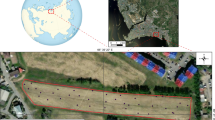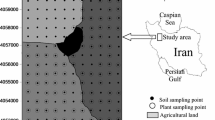Abstract
Based on the physicochemical characteristics, metals emitted from the source (both natural and anthropogenic) contributes towards spatial continuity at a regional scale. Apart from the intrinsic properties of metals, meteorological conditions and topography of the region are also known to contribute towards spatial continuity. In the present study, a comparative spatial assessment of 12 metals in lichen Phaeophyscia hispidula collected from mountains and plains of northern and north-central India was carried out with the help of the indicator kriging method. The total metal concentration varies between 25.4–429 µgg−1 and 22.8–507 µgg−1 dry weight in plains and mountains, respectively. The ‘Indicator Kriging’, a cokriging non-parametric approach has been applied to predict the total metal load (TML) probability from a regional lichen database derived from the different metals in the mountain and plain regions. Cr, Cd, Cu and Pb had higher concentrations having higher coverage area, while metals like Cd and Hg had the highest localized distribution indicating point sources. The probability values of TML are further related with topography, population density and land cover attributes to specific factors responsible for metal accumulation in the study area. Observations indicated that apart from local sources, topography, population density and land cover, also plays an essential role in the spatial behaviour of the metals, which has been verified by the bioaccumulation pattern of metals in lichen samples from the mountainous region. Among which three mountainous states of Northern India, Uttarakhand has a higher concentration of metals which may be attributed to the topography and local anthropogenic sources.









Similar content being viewed by others
Availability of data and materials
The lichen voucher specimen was deposited in the herbarium of the CSIR-National Botanical Research Institute, Lucknow (LWG), India.
References:
Adhikary PP, Dash CJ, BejR CH (2011) Indicator and probability kriging methods for delineating Cu, Fe, and Mn contamination in groundwater of Najafgarh Block, Delhi. India Environmental Monitoring and Assessment 176(1):663–676
Bajpai R, Upreti DK, Mishra SK (2004) Pollution monitoring with the help of lichen transplant technique at some residential sites of Lucknow. J Environ Biol 25(2):191–195
Bajpai R, Upreti DK, Nayaka S, Kumari B (2010) Biodiversity bioaccumulation and physiological changes in lichens growing in the vicinity of coal based thermal power plant of Raebareli district, north India. J Hazard Mater 174:429–436
Bajpai R, Shukla V, Upreti DK, Semwal M (2014) Selection of suitable lichen species for monitoring climatic variability in the Himalaya. Environ Sci Pollut Res 21:11380–11394
Berke O (2004) Exploratory disease mapping: kriging the spatial risk function from regional count data. Int J Health Geogr 3:18. https://doi.org/10.1186/1476-072X-3-18
Buchhorn M, Smets B, Bertels L, De Roo B, Lesiv M, Tsendbazar N-E, Herold M, Fritz S (2019) Copernicus global land service: land cover 100m: collection 3: epoch 2019. Globe 2020. https://doi.org/10.5281/zenodo.3939050
Cattle JA, Alex B, Bratney MC, Minasny B (2002) Kriging method evaluation for assessing the spatial distribution of urban soil lead contamination. J Environ Qual 31:1576–1588
CIESIN (2018) Center for International Earth Science Information Network - CIESIN - Columbia University.2018. Gridded Population of the World, Version 4 (GPWv4): Population Density, Revision 11. Palisades, NY: NASA Socioeconomic Data and Applications Center (SEDAC).doi: https://doi.org/10.7927/H49C6VHW.
Devi V, Atique MM, Raju A, Upreti G, Jigyasu DK, Yadav JK, Singh S, Kar R, Singh M (2021) Mercury transportation dynamics in the ganga alluvial plain, northern india: a study of rainwater-groundwater-river water interaction from a global hotspot region. Int J Environ Sci Technol. https://doi.org/10.1007/s13762-021-03334-x
Dwivedi S, Triparthi RD, Kumar A, DaveR MS, Singh R, Sharma D, Rai UN, Charakaborty D, Trivedi PK, Adhikari B, Bag MK, Dhankar OP, Tuli R (2010) arsenate exposure affects amino acids, mineral nutrient status and antioxidants in rice (Oryza sativa L.) genotypes. Environ Sci Technol 44:9542–9549
Garty J (2001) Biomonitoring atmospheric heavy metals with lichens: theory and application. Crtital Rev Plant Sci 20(4):309–371
Goovaerts P, AvRuskin G, Meliker J, Slotnick M, Jacquez G, Nriagu J (2005) Geostatistical modeling of the spatial variability of arsenic in groundwater of southeast Michigan. Water Resour Res 41(7):W07013. https://doi.org/10.1029/2004WR003705
GTOPO30 (1996) 30 arc-second DEM of Asia, U.S. Geological Survey’s Center for Earth Resources Observation and Science (EROS), 1996.
Hohn M (1999) The semivariogram. In: geostatistics and petroleum geology. Springer. https://doi.org/10.1007/978-94-011-4425-4_2
Juang KW, Lee DY (2000) Comparison of three nonparametric kriging methods for delineating heavy metal contaminated soils. J Environ Qual 29:197–205
Lam NS (1983) Spatial interpolation methods: a review. Am Cartogr 10:129–149
Li P, Feng XB, Qui GL, Shang LH, Li ZG (2009) Mercury pollution in Asia: a review of the contaminated sites. J Hazard Mater 168:591–601
Liu HJ, Zhao LC, Fang SB, Liu SW, Hu JS, Wang L, Liu XD, Wu QF (2016) Use of the lichen Xanthoriamandschurica in monitoring atmospheric elemental deposition in the Taihang Mountains, Hebei, China. Scientific Report 6:23456. https://doi.org/10.1038/srep23456
Matheron G (1963) Principles of geostatistics. Econ Geol 58(8):1246–1266. https://doi.org/10.2113/gsecongeo.58.8.1246
Mitas L, Mitasova H (1999) Spatial Interpolation. In: Longley P, Goodchild MF, Maguire DJ, Rhind DW (eds) Geographical Information Systems: Principles, Techniques, Management and Applications. Wiley, New jersey
Munteanu V, Munteanu G (2007) Biomonitoring of mercury pollution: a case study from the Dniester River. Ecological Indicator 7:489–496
Passarella G, Vurro M, D’agostino V, Giuliano G, Barcelona MJ (2002) A probabilistic methodology to assess the risk of groundwater quality degradation. Environ Monit Assess 79(1):57–74
Raju A, Singh A, Srivastava N, Singh S, Jigyasu DK, Singh M (2019) Mapping human health risk by geostatistical method: a case study of mercury in drinking groundwater resource of the central ganga alluvial plain, northern India. Environ Monit Assess 191(Supp. 2):298. https://doi.org/10.1007/s10661-019-7427-y
River Data Compilation (2018) Status of trace and toxic metals in Indian rivers. River data compilation-2, Directorate Planning and Development Organization, River Development and Ganga Rejuvenation, Central Water Commission, Minstry of Water Resources, Government of India, 2018.
Serelis KG, Kafkala IG, Parpodi K, Lazaris S (2010) Anthropogenic and geogenic contamination due to heavy metals in the vast area of Vari, Attica. Bulletin Geol Soc Greece 43:2390–2397
Shukla V, Upreti DK (2007) Heavy metal accumulation in Phaeophyscia hispidula en route to Badrinath, Uttaranchal, India. Environ Monit Assess 131:365–369
Shukla V, Upreti DK, Bajpai R (2014) Lichen to Biomonitor the Environment (Ed). Springer Publishing, Netherland
Sloss L (2012) Mercury emission from India and South-East Asia. Rep, United Nation Environ Progr 2012:9
Watson DF (1992) Contouring: a guide to the analysis and display of spatial data. Pergamon, Oxford
Acknowledgements
Authors are thankful to Prof. S. K. Barik, Director, CSIR-National Botanical Research Institute, Lucknow, for providing laboratory facilities for work. The authors RB and DKU thanks to the Council of Scientific and Industrial Research, New Delhi, for award of Scientist Pool fellowship (8909-A) and Emeritus scientist fellowship (21/1045/18/EMR-II), respectively. VS acknowledges SR/FTP/ES-39/2013. This manuscript bears CSIR-NBRI, communication Number CSIR-NBRI-MS/2020/11/07.
Funding
Council of Scientific and Industrial Research, New Delhi.
Author information
Authors and Affiliations
Contributions
Author RB, VS: collected samples, RB: perform metal estimation and writing first draft of manuscript. VS, RB and AR: in writing and finalizing the manuscript. AR: performed kriging analysis of data. Authors CPS and DKU: provide fruitful discussions and comments for improving the manuscript.
Corresponding author
Ethics declarations
Competing interest
The authors declare that they have no conflict of interests.
Ethical approval
This article does not contain any studies with human or animals’ participants.
Consent to participate
All authors given his/her consent to participate in the manuscript.
Consent to publish
All authors have given his/her consent for publication and authors have no conflicts of interest.
Additional information
Publisher's Note
Springer Nature remains neutral with regard to jurisdictional claims in published maps and institutional affiliations.
Rights and permissions
About this article
Cite this article
Bajpai, R., Shukla, V., Raju, A. et al. A geostatistical approach to compare metal accumulation pattern by lichens in plain and mountainous regions of northern and central India. Environ Earth Sci 81, 203 (2022). https://doi.org/10.1007/s12665-022-10336-6
Received:
Accepted:
Published:
DOI: https://doi.org/10.1007/s12665-022-10336-6




